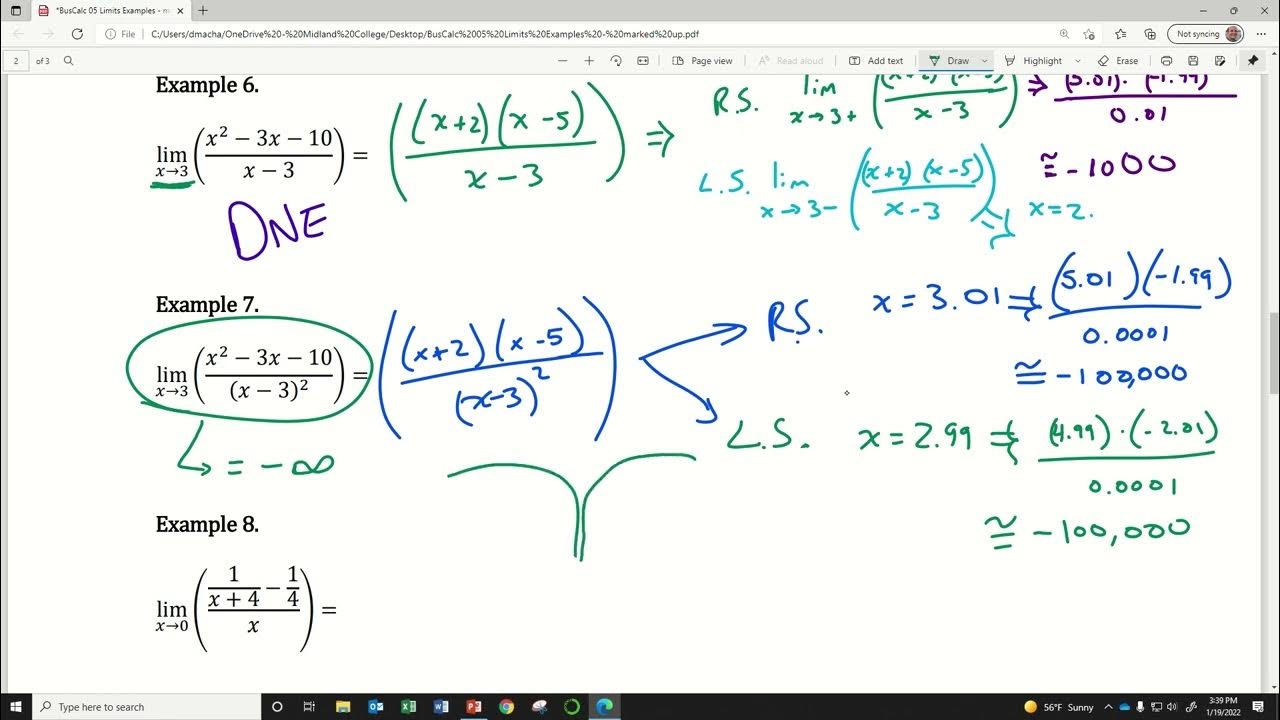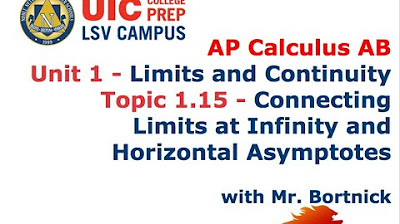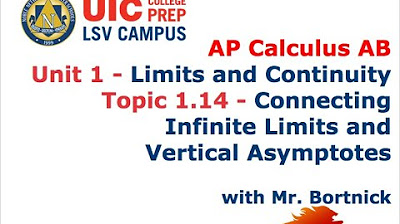Calculus AB Homework 1.2 Understanding the Limit
TLDRThis video tutorial comprehensively explores unit 1 homework problems 4 through 8, focusing on evaluating limits of functions. It covers two-sided limits, horizontal asymptotes, and the non-existence of limits due to infinite values or differing approaches. The presenter simplifies algebraic expressions to find exact limits, discusses domain restrictions, and graphically illustrates function behavior with examples, including removable discontinuities and holes in graphs.
Takeaways
- 📚 The video covers the evaluation of limits in a math homework assignment, focusing on problems 4 through 8 from Unit 1.
- 🔍 Limits are approached from both directions, and the existence or non-existence of the limit is determined by whether the left and right limits match and are finite.
- 📉 In the case of problem 4B, the function approaches positive and negative infinity from the left and right sides of x = -3, respectively, indicating the limit does not exist.
- 📈 For problem 4C, the function approaches a y-value of +3 as x approaches 3 from the right-hand side.
- 🔢 The limit of f(x) as x approaches 4 from both sides is 2, indicating a two-sided limit exists and is equal to 2.
- ∞ When x approaches negative infinity, the function approaches a horizontal asymptote at 2, while as x approaches positive infinity, the function's limit is infinity.
- 🔄 Problem 5 discusses the non-existence of a limit at x = -4 due to differing left and right limits.
- 📉 The video explains how to find the domain of a function by identifying values that make the denominator zero and excluding them.
- 📊 In problem 6, a table of values is used to estimate the limit as x approaches 2, numerically showing the approach to -8 despite the function being undefined at x = 2.
- 📐 Algebraic simplification in problem 6C reveals a removable discontinuity at x = 2, confirming the limit as x approaches 2 is -8.
- 📈 The video concludes with constructing accurate graphs for functions based on their limits and domain, illustrating the behavior of the functions at specific points and asymptotes.
Q & A
What is the process for evaluating a two-sided limit in the given script?
-The process involves checking the limit from both the left-hand side and the right-hand side. If the function values approach the same y-value from both sides, the limit exists and is equal to that y-value. If the values differ or approach infinity or negative infinity, the limit does not exist.
Why does the limit not exist for the function as X approaches negative 3 in the script?
-The limit does not exist because the function approaches infinity from the left-hand side and negative infinity from the right-hand side, indicating that the left-hand limit and the right-hand limit are not equal, and the function is not approaching a finite value.
What is the domain of the function f(x) in the script's Part 6?
-The domain of f(x) is all real numbers except for the values that make the denominator zero, which are x = plus or minus 2. In interval notation, this can be expressed as (-∞, -2) U (-2, 2) U (2, ∞) or all real numbers X such that X ≠ ±2.
How is the limit of f(x) as X approaches 2 estimated in the script?
-The limit is estimated by creating a table of values for X near 2, both from the left and the right, and observing the f(x) values. The values numerically approach -8, indicating the limit is -8.
What is the significance of a removable discontinuity or a hole in the graph of a function?
-A removable discontinuity or a hole in the graph signifies that the function is not defined at that particular x-value, but the limit as X approaches that value still exists.
How is the expression 16 - x^4 over x^2 - 4 simplified in the script?
-The expression is simplified by factoring it as the difference of squares, resulting in (4 + x^2)(4 - x^2) / (x + 2)(x - 2), which further simplifies to -4 - x^2 after canceling out common factors, leaving a negative sign.
What is the domain of the function g(x) in the script's Part 7?
-The domain of g(x) is all real numbers except for x = -3, as this value makes the denominator zero and is not included in the domain.
Why does the limit of g(x) as X approaches -3 not exist according to the script?
-The limit does not exist because the function approaches different values from the left-hand side (approaching 1) and the right-hand side (approaching -1), indicating no single value that the function approaches as X gets closer to -3.
How is the expression for g(x) simplified using algebra in the script?
-The expression is simplified by considering the absolute value and replacing it with a piecewise function, which equals 1 for x < -3 and -1 for x > -3, confirming that the limit as X approaches -3 does not exist.
What is the process for constructing an accurate graph of y = f(x) based on the script's instructions?
-The process involves plotting specific points given in the script, such as f(-2) = 2, and considering the behavior of the function near certain values like the hole at x = 2 and the asymptote at x = 1. The graph is then sketched to reflect these properties, including the limits and undefined points.
Outlines
📚 Evaluating Limits in Homework Problems
This paragraph discusses the process of evaluating limits for a function in various scenarios. It begins with finding the limit as X approaches -5 from both sides, which converges to 5. Next, it addresses the non-existence of the limit as X approaches -3 due to the function approaching infinity from the left and negative infinity from the right. The paragraph continues with limits involving approaching 3 from the right, yielding a limit of 3, and a two-sided limit as X approaches 4, which equals 2. It also covers limits at infinity and negative infinity, illustrating horizontal asymptotes and unbounded behavior. The section concludes with limits involving negative 4, where the left-hand limit differs from the right-hand limit, indicating a non-existent limit.
🔍 Detailed Limit Analysis and Domain Determination
The second paragraph delves into the specifics of limit evaluation for a function given by f(X) = (16 - X^4) / (X^2 - 4). It starts with determining the domain of the function, excluding values that make the denominator zero, which are X = ±2. The domain is expressed in interval notation. The paragraph then uses a table of values to estimate the limit as X approaches 2, revealing the function approaches -8 from both sides, despite being undefined at X = 2. Algebraic simplification of the function is performed, showing a removable discontinuity at X = 2, where the simplified expression confirms the limit is -8. The paragraph concludes with true/false questions regarding the simplified expression and the function's behavior at specific points.
📉 Limit Estimation and Graph Construction for G(X)
This paragraph focuses on the function G(X) = -|X + 3| / (X + 3) and its behavior as X approaches -3. It begins by estimating the limit using a table of values, suggesting the limit does not exist due to differing values from the left and right. The expression for G(X) is simplified using algebra, revealing a piecewise definition with the function being 1 for X < -3 and -1 for X > -3, and undefined at X = -3. The paragraph addresses true/false questions about the function's value at -3 and its equivalence to -1, concluding with instructions to construct a graph of G(X) from -4 to -2, indicating the function's behavior and the undefined point at -3.
📈 Graph Sketching with Given Properties and Limits
The final paragraph provides a series of properties and limits to guide the construction of a graph for a function F(X). It starts with plotting points and discussing the existence of limits at specific X values, such as F(-2) = 2, F(-1) = 3, and F(1) being undefined with a limit of 0 as X approaches 1. The paragraph also addresses the non-existence of the limit as X approaches 2 and suggests how the graph might connect these points, including potential holes or asymptotes. The paragraph concludes with a similar exercise for another function G(X), emphasizing the importance of plotting points, understanding limits, and considering undefined values in graph construction.
Mindmap
Keywords
💡Limit
💡Two-sided limit
💡Horizontal asymptote
💡Removable discontinuity
💡Undefined
💡Domain
💡Piecewise function
💡Asymptote
💡Factoring
💡Table of values
Highlights
Evaluating two-sided limits for a function as x approaches specific values.
Limit exists when left and right-hand side approaches the same value.
Limit does not exist if approached values are unbounded or differ on each side.
Approaching a function's horizontal asymptote as x approaches negative infinity.
Function's behavior as x approaches infinity can indicate the limit.
Determining non-existence of a limit when left and right-hand limits differ.
Estimating limits using a table of values near a critical point.
Simplifying algebraic expressions to evaluate limits exactly.
Identifying removable discontinuities or holes in a function's graph.
Domain of a function excludes values that make the denominator zero.
Using piecewise functions to represent different behaviors on either side of a discontinuity.
Constructing accurate graphs based on limit information and function values.
Understanding that a function's value at a point does not necessarily equal the limit at that point.
Sketching graphs with specific properties such as points, limits, and undefined values.
Analyzing the behavior of a function with absolute value in the numerator.
Determining the non-existence of a limit when left and right-hand side limits are different.
Creating a graph with asymptotes and holes based on limit properties.
Transcripts
Browse More Related Video

Calculus 1 Review - Basic Introduction

Calculus AB Homework 1.4 Limits Involving Infinity

BusCalc 05 Limits Examples Pt 2

AP Calculus AB - 1.15 Connecting Limits at Infinity and Horizontal Asymptotes

AP Calculus AB - 1.14 Connecting Infinite Limits and Vertical Asymptotes

Three Types of Discontinuities in Functions
5.0 / 5 (0 votes)
Thanks for rating: